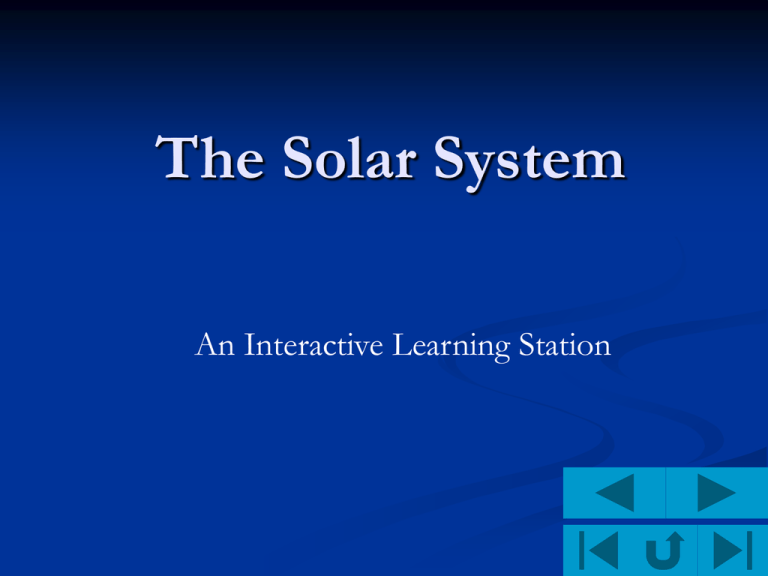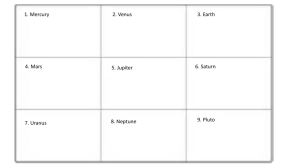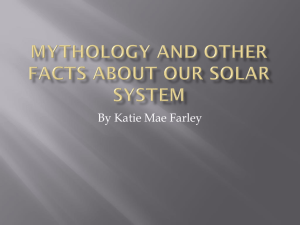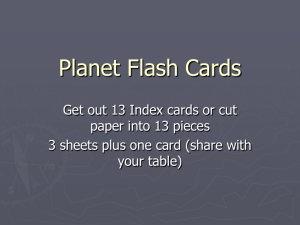The Solar System
advertisement

The Solar System An Interactive Learning Station The Planets Currently, there are nine planets which have been discovered. They include: Mercury Neptune Venus Saturn Earth Uranus Mars Pluto Jupiter Mercury Closest to the sun. Only visited by one spacecraft: Mariner 10. Orbits the sun every 88 days. Temperatures can reach 467 degrees Celsius. Second smallest planet to Pluto. Surface resembles the moon because meteorites can not burn up – there is practically no atmosphere. Venus Similar to Earth in size, mass and composition Covered with clouds that trap in heat, creating a greenhouse effect. Rotates once every 243 Earth days and orbits the Sun every 225 days – this makes its day is longer than its year! Earth Only planet known to have life. Earth has seasons because its axis is tilted 23 degrees. Oceans cover 70% of Earth’s surface. Has one satellite: the moon. Mars Small, red, rocky planet. Has two small moons. Experiences large dust storms. Water ice was discovered in 2002 – this discovery will aid scientists in answering the question, “Is there, was there, or will there be life on Mars?” Has the largest volcano in space. Jupiter Largest planet. Has three rings. Surface is probably gases and liquids. Our VIP – Galileo – discovered 4 of Jupiter’s moons: Io, Europa, Ganymede, and Callisto. Jupiter officially has 52 moons - the most in the solar system. Saturn In 1610, Galileo became the first astronomer to see Saturn through a telescope. Made mostly of hydrogen and helium. The rings of Saturn are made of mostly water ice. Saturn has at least 30 moons. The largest is Titan and is a bit bigger than Mercury. Uranus The blue-green color comes from methane gas. It takes 84 years for Uranus to complete one revolution around the sun. Seasons in Uranus last about 20 years due to it’s unique horizontal tilt. Uranus has 11 rings and at least 20 moons. Neptune Neptune was the first planet to be discovered by using mathematics rather than observations of the sky. Neptune was discovered in 1846. Its orbit is 165 years, therefore it has yet made a full circle around the Sun since it was discovered. Neptune's largest moon, Triton, gets colder than Pluto. Pluto Pluto is so far away that is it difficult for scientists to learn about it. The outer fringes of our solar system await close-up observations by a robotic space flight mission. Pluto is different from the rest of the planets. It may be the largest of a group of icy objects just beyond Neptune called the Kuiper Belt. Self Check Question One Which planet has frequent dust storms? Earth Pluto Uranus Mars Correct! Next Question Self Check Question Two Which planet has seasons that last 20 years? Mercury Jupiter Uranus Mars Correct! Next Question Self Check Question Three Which planet has the most moons? Jupiter Earth Venus Pluto Correct! Next Question Self Check Question Four Which planet was discovered using mathematics rather than observation? Saturn Neptune Venus Pluto Correct! Next Question Self Check Question Five Which Planet’s surface resembles the moon’s? Jupiter Mercury Neptune Saturn Congratulations! You have completed the interactive learning station! References NASA Kids Goodman, Polly. Space & Art Activities. New York: Crabtree Pub, 2002. Simon, Seymour. Planets Around the Sun. New York: Seastar Books, 2002. Nine Planets Exit Learning Station






